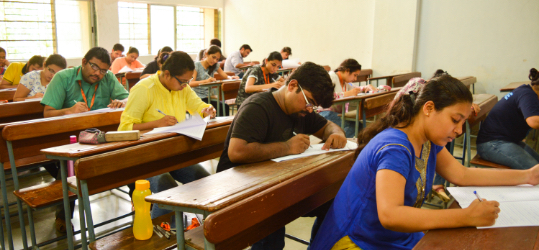The evaluation of theory of 100 marks is done in two parts, internal component
Continuous Internal Assessment (CIA) carrying maximum of 40 marks and by the Semester End Examination (SEE) carrying maximum of 60 marks.
The aggregate minimum for a pass in eachcourse is 40%.

Internal assessment: Internal examination is of continuous evaluation type based on the guidelines set by the Academic Council.
It carries 40 marks and a student is required to obtain a minimum of 16 marks for each of the courses. A student is required to opt for one of the two options for their internal assessment namely A or B. A student can opt for option B for not more than 50% of their courses (both inclusive).
Option A: Test and Assignment: The mid semester test (25 marks) will ideally be objective type evaluation but it can be a mix of objective and descriptive questions. The assignment (15 marks) should be given well in advance so that they have sufficient time for it.
Option B: Project based evaluation: The student is required to select one of the projects offered by the mentor (generally the teacher teaching the course). The project will be evaluated by the end of the respective semester. The student will make a self- written report which also contains their own observation, analysis and conclusions. The assessment will be based on the report and presentation of their project. The project can go beyond the scope of the syllabus.
Semester End examination (SEE): It carries 60 marks and a student is required to obtain a minimum of 24 marks for each of the course. For all courses the duration of the examination is of two hours except for Sem V and VI of Science and M.Sc. which are of two and a half hours duration.
Practical examination: In general it carries 100 marks for each practical course and a student is required to obtain a minimum of 40 marks to pass a practical course. Some programmes may have a different maximum marks allotted for the practical course but the student will need to secure a minimum of 40% in each of the practical courses.
Internal assessment: The departments are given autonomy to decide the modality of internal assessment in their respective subjects.
The internal component consists of two parts. Test of 20 marks and 20 marks assignment. Departments are free to conduct any number of tests for the 20 marks component. The assignments can be in the form of power- point presentation, write up , research paper review etc.
Semester End examination (SEE): It carries 60 marks and a student is required to obtain a minimum of 24 marks for each of the course.
Semester IV is completely project based where the students will work in industry/ research institutes for 4- 6 months and finally tested by the end of April/May on the project.
ATKT: A student who has failed in internal and semester end of the same course and has passed all other courses is said to have failed in that course and is said to have one ‘KT’. Students can count the number of ‘F’ in the grade column of their mark sheet to find the number of ‘KT’.A student is required to make themselves aware of the rules for promotion so that they do not lose a year. Read the rules for promotion/ATKT.
Students with disabilities: Students with learning disabilities are required to apply for concessions, as prescribed by the Mumbai University, to the examination cell well in advance with proper documents.
Attendance: Students are required to have a minimum of 75% attendance to be allowed to give their examination.
Students have to submit a medical certificate to the Attendance committee for any leave taken under medical reason for the lectures missed. A student who misses the lecture because of representing the college for any kind of event is required to submit the application along with the relevant report from the concerned faculty.
A student who misses their examination due to any reasons as mentioned above are required to intimate the examination cell in writing with all necessary documents. If the student is required to go for any camp/training (NCC/NSS) , they are required to obtain prior permission in writing.
There are some ordinances that can be used to pass the programme or upgrade their grade. Students are requested to read the rules displayed under ordinances. A student who has taken NSS/NCC/ DLLE/ sports*/ cultural* etc can also get certain grace marks under ordinance O.229. Students are requested to read the same.
All the registered students shall be given a marksheet after the completion of each Semester. This will indicate the Letter Grade and Credits earned. It will show the details of the Course (Course Code, Title, No. of Credits, and Grade Earned etc.) Credits earned, SGPA, and CGPA.
| Marks | Grade Points | Grade | Performance |
|---|---|---|---|
| 80 & Above | 10 | O | Outstanding |
| 70-79.99 | 9 | A+ | Excellent |
| 60-69.99 | 8 | A | Very Good |
| 55-59.99 | 7 | B+ | Good |
| 50-54.99 | 6 | B | Above Average |
| 45-49.99 | 5 | C | Average |
| 40-44.99 | 4 | D | Pass |
| Less than 40 | 0 | F | Fail |
| GPA | Grade | Performance |
|---|---|---|
| 10 | O | Outstanding |
| 9.0-9.99 | A+ | Excellent |
| 8.0-8.99 | A | Very Good |
| 7.0-7.99 | B+ | Good |
| 6.00-6.99 | B | Above Average |
| 5.00-5.99 | C | Average |
| 4.00-4.99 | D | Pass |